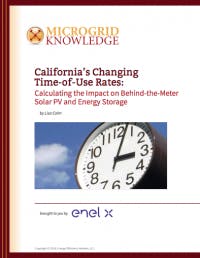In California, it can get expensive and complex for utilities to deliver electricity when demand is high. To help mediate these costs, California’s utilities offer time-of-use (TOU) rates, prices for power based on demand trends on the grid. A new white paper from Enel X explores how behind-the-meter solar PV and energy storage are aligning to shift the state’s historic time-of-use rates.
Download the full report.
So, here’s how it has traditionally worked. When demand is at its peak, then the prices under TOU rates are elevated. Historically, grid demand kicks up in the morning, peaks from noon into the early afternoon, and then decreases as the day moves on. Specifically, California’s utilities have long scheduled on-peak hours from around 11 a.m. to 6 p.m. These TOU rates served to increase review of utilities to help cover the cost of delivering power when demand is high.
It makes sense for utilities to take these measures, but for energy consumers, this energy layout created an incentive to minimize reliance on the grid for power during on-peak hours. And this is the trend that in large part has pushed the value of on-site solar photovoltaics (PV) for the state’s large energy consumers. Not surprisingly, the highest level of solar generation occur during the California on-peak hours, which cuts down on costs for high energy users.
That said, the rise of solar power in the state have “disrupted the dynamics of the supply mix” in California’s electric grid, according to the new report from Elon X. In light of this, utilities are changing their TOU rate schedules, and this is bound to impact the business case for behind-the-meter solar PV and energy storage systems.
According to the U.S. Energy Information Administration, from 2007-2017, utility-scale solar power generation in California grew from 557 GWh to 24,353. This jump has created a difficult landscape for state utilities, which turn to natural gas generation for most of the power on the grid. Solar production, like peak hours for the utilities, increases in the late morning hours and peaks around noon, before decreasing in the late afternoon. This, of course, cuts down on demand for natural gas during peak hours, eroding utility’s revenue. California’s Independent System Operator (CAISO) coined this the “duck curve,” outlined in the report, which creates several additional challenges for utilities, including spikes in demand, decreases in electricity prices and more.
According to the U.S. Energy Information Administration, from 2007-2017, utility-scale solar power generation in California grew from 557 GWh to 24,353.
In response to these changes, California’s utilities have begun adjusting their TOU rate schedules to account for this so-called duck curve. San Diego Gas & Electric (SDG&E), for example, shifted on-peak hours for its summer season to 4 p.m.-9 p.m., from its previous schedule of 11 a.m.-6 p.m. Pacific Gas & Electric (PG&E) and Southern California Edison (SCE) are expected to follow suit.
Utilities will also have to begin calculating the impact of the new TOU rate scheduled on solar PV and energy storage. Under the new TOU rate schedules, peak production for a solar PV system will occur largely during the new off-peak hours at midday. As a result, the value of stand-alone solar PV will drop, since it’s power to minimize costs during on-peak hours will diminish, thus impacting the business case for stand-alone energy storage.
According to the new Enel X report, the impending change in TOU rate schedules came as a “result of a fundamental shift to a more renewable-heavy power generation mix.”
Download the new report, courtesy of Enel X, “California’s Changing Time-of-Use Rates: Calculating the Impact on Behind-the-Meter Solar PV and Energy Storage,” to learn more about how the state’s energy market dynamics are evolving, making energy storage and DERs even more important to California’s economy.







